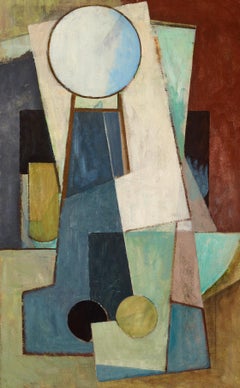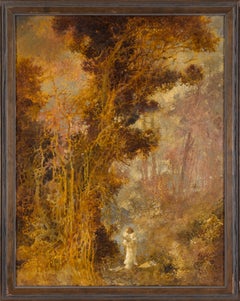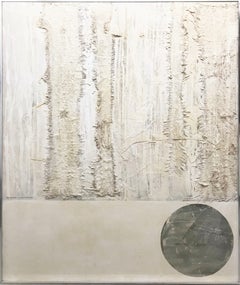Henry Fitch Taylor Art
to
1
Overall Width
to
Overall Height
to
1
1
1
1
1
1
1
1
1
9,445
2,689
1,375
1,359
1
1
Artist: Henry Fitch Taylor
Figure with Guitar II
By Henry Fitch Taylor
Located in Bryn Mawr, PA
Provenance
Noah Goldowsky Gallery, New York;
Collection of Jeptha H. Wade and Emily Vanderbilt Wade, Boston, until 2025
Exhibitions
Cleveland Museum of Art, Art for Collectors, 1971...
Category
1910s American Modern Henry Fitch Taylor Art
Materials
Canvas, Oil
Related Items
Woman and Child in the Woods - Midcentury Abstracted Landscape in Oil on Canvas
Located in Soquel, CA
Woman and Child in the Woods - Midcentury Abstracted Landscape in Oil on Canvas
Dramatic abstracted painting of a woman holding a child in the woods by Maley (20th Century). This pi...
Category
1970s American Modern Henry Fitch Taylor Art
Materials
Canvas, Oil, Stretcher Bars
$2,500
H 26.5 in W 21 in D 1 in
Large Scale Modernist Abstract Square and Circle
Located in Soquel, CA
Wonderful large scale natural toned mixed media abstract comprising a rectangle of antiqued white texturized with gesso'd hemp sacking and set above second ivory rectangle in pale ivory with circle of scumbled grey by British contemporary artist Richard Lawrence...
Category
1980s American Modern Henry Fitch Taylor Art
Materials
Gesso, Canvas, Oil
$3,256 Sale Price
45% Off
H 59.75 in W 50 in D 1.5 in
"Shattered" WPA Mid 20th Century Modernism American Scene Surrealism Figurative
By Leon Bibel
Located in New York, NY
"Shattered" WPA Mid 20th Century Modernism American Scene Surrealism Figurative
Estate stamp on the stretcher, verso. Provenance: Estate of the artist. 20 x 24 inches.
Look at the last two photos in the listing. A new book about Leon Bibel was just published and there's a photo of the artist taken in front of the painting. Amazingness.
BIO
Leon Bibel continued painting through 1941 and resumed work in both painting and especially wood sculpture by 1960. He worked until his very last day in 1995. His last series of large wood sculptures were modeled on spice boxes, which were miniature buildings...
Category
1930s American Modern Henry Fitch Taylor Art
Materials
Canvas, Oil
"Backstage, Ambassador" Broadway Theatre NYC Mid-century Modern Modernist Cubist
By Sam Norkin
Located in New York, NY
"Backstage, Ambassador" Broadway Theatre NYC Mid-century Modern Modernist CubistSigned lower left, titled on the stretcher.
Norkin was a Brooklyn, Ne...
Category
1940s American Modern Henry Fitch Taylor Art
Materials
Canvas, Oil
Carl Holty Abstract Oil Painting "Riviera" in Primary Colors
By Carl Robert Holty
Located in Detroit, MI
"Riviera" is an exquisite painting of American Modern - primary colors actively composed in energetic movement and structure on the painted surface. These colors formulate the painting, play both for and against each other and create a lively surface with hints of either an architectural structure or freeway. This painting hints to future Modernists such as Richard Diebenkorn "Driveway" and David Hockney "Garrowby." Unframed the piece measures 18 x 24.
"Riviera" is signed on lower left. On verso is Provenance of over 70 years, 3 galleries in New York and one in Detroit, Michigan: Andrew Crispo Gallery, Sid Deutsch Gallery and Linda Hyman Gallery in New York and Collected Detroit Gallery in Detroit, Michigan.
Abstractionist Carl Robert Holty was known for his biomorphic abstract forms as well as the geometric abstractions he painted with his vibrant color palette. Born in Frieburg, Germany his family immigrated to the United States settling in Wisconsin. In 1919, he enrolled at the Art Institute of Chicago, and shortly thereafter attended the Parsons School of Design. He spent a short time at the National Academy of Design and studied with Francis Coates Jones...
Category
Mid-20th Century American Modern Henry Fitch Taylor Art
Materials
Oil, Canvas
$24,000
H 22 in W 28 in
"On Guard" Heavy Impasto Expressionist Figure
Located in Soquel, CA
"On Guard" Vintage Abstract Expressionist Heavy Impasto Figure
Abstract expressionist figurative composition of a man in a button down shirt with a brimmed hat by California artist ...
Category
1970s American Modern Henry Fitch Taylor Art
Materials
Canvas, Oil, Stretcher Bars
Abstraction
By Robert Noel Blair
Located in Buffalo, NY
You are viewing a modern abstract painting by Robert Blair.
Robert Noel Blair (American, 1912-2003) was an American artist, painter, sculptor, printmaker and teacher. He is best k...
Category
1960s American Modern Henry Fitch Taylor Art
Materials
Canvas, Oil
Wilma Fiori 1994 Abstract Oil Painting, Large Horizontal Modernist Canvas
Located in Denver, CO
This original 1994 abstract oil painting by Wilma Fiori (1929–2019) presents a rich, moody composition in a commanding large horizontal format. Signed and ...
Category
1990s American Modern Henry Fitch Taylor Art
Materials
Canvas, Oil
$9,000
H 38.25 in W 54 in D 1.25 in
Still Life of Fruit on Table Style of Paul Cézanne
Located in Soquel, CA
Modern Cézanne style still life with collage by Dorothy Jane (Milne) Eggen (American, 1907-1986) Her still life is a Homage to Paul Cézanne's ...
Category
1960s American Modern Henry Fitch Taylor Art
Materials
Canvas, Oil, Illustration Board, Newsprint
$2,650
H 22.75 in W 26.5 in D 0.75 in
"Personage" Heavy Impasto Expressionist Portrait of Lady with a Hat
Located in Soquel, CA
"Personage" Heavy Impasto Expressionist Portrait of Lady with a Hat
Abstract expressionist portrait of a woman wearing a hat by California artist Harald "Harry" Dry Schmidt (America...
Category
1970s American Modern Henry Fitch Taylor Art
Materials
Canvas, Oil, Stretcher Bars
$2,150
H 21 in W 20 in D 1 in
"So What How?" - Abstract Expressionist Earth Tone Abstract in Oil on Canvas
By John O. Thomson
Located in Soquel, CA
"So What How?" - Abstract Expressionist Earth Tone Abstract in Oil on Canvas
Expressive abstract work in earth tones by Monterey Bay artist and gallery owner John O. Thomson (Americ...
Category
1970s American Modern Henry Fitch Taylor Art
Materials
Canvas, Oil, Stretcher Bars
$2,720 Sale Price
20% Off
H 38 in W 26 in D 2 in
Colorful Samurai, Large-Scale Modern Figural Geometric Abstract
Located in Soquel, CA
Colorful Samurai, Large-Scale Modern Figural Geometric Abstract
Colorful modern figural abstract of a samurai figure fractured into fields of color and pattern by S. Baker (Susan Baker...
Category
1990s American Modern Henry Fitch Taylor Art
Materials
Canvas, Oil, Stretcher Bars
$3,650
H 42 in W 36 in D 2 in
Henry Fitch Taylor art for sale on 1stDibs.
Find a wide variety of authentic Henry Fitch Taylor art available for sale on 1stDibs. Customers who are interested in this artist might also find the work of Mercedes Matter, Rocky Hawkins, and Rob Brooks.


